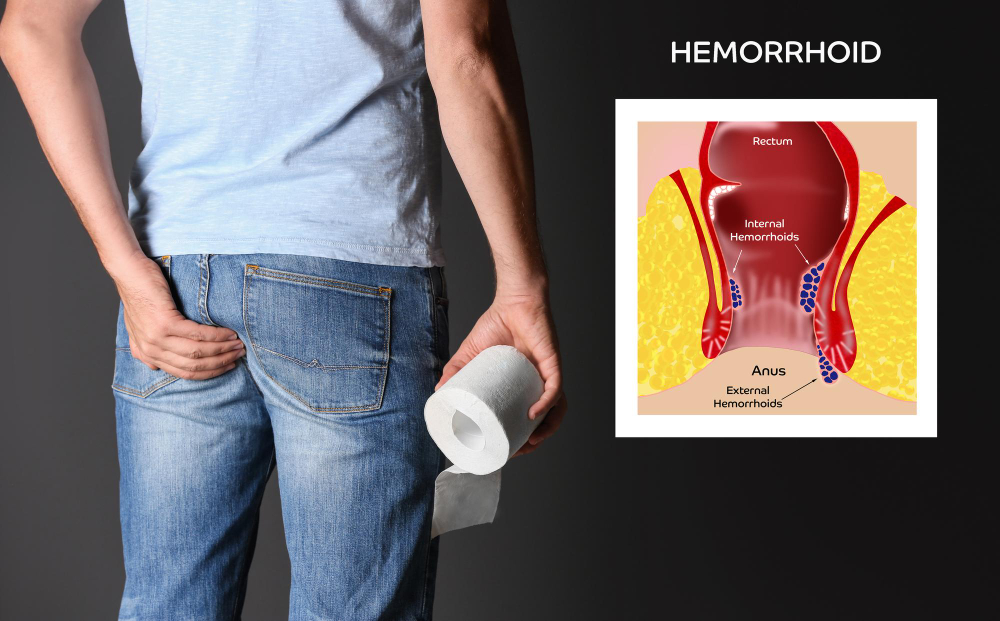Hemorrhoids, while often uncomfortable and sometimes a little embarrassing to talk about, are incredibly common. Understanding the symptoms of hemorrhoids is the first step toward getting the relief you need.
Hemorrhoids are swollen veins that appear in your rectum (internal hemorrhoids) or around the anus (external hemorrhoids). These two types of hemorrhoids are caused by increased pressure in the area, often from straining during bowel movements, pregnancy, or prolonged sitting.
Hemorrhoidal symptoms can vary, but it’s important to see a doctor if you notice them, as other conditions may present similarly.
5 Most Common Hemorrhoid Symptoms: Quick Facts
- Bright red blood on toilet paper or in the toilet bowl.
- Pain, burning, and discomfort around the anal area.
- Swelling or lumps around the external anus.
- Difficulty cleaning after a bowel movement.
- General anal irritation and inflammation.

Identifying The Symptoms of Hemorrhoids
Understanding the symptoms of hemorrhoids is crucial, as they can vary significantly depending on whether the hemorrhoids are internal or external. It’s important to dispel common misconceptions that all hemorrhoids cause pain or visible signs.
In fact, many people with internal hemorrhoids may not realize they’ve them until they notice rectal bleeding. For those experiencing external hemorrhoids, symptoms like anal itching, discomfort, and a hard lump near the anus are more prominent. Managing discomfort becomes a priority in such cases.
Common Symptoms of Hemorrhoids In Male
Both men and women can experience hemorrhoid symptoms, though they may differ slightly between genders. Although there are no proven connections between hemorrhoids and gender, a new study finds that males are a bit more prone to hemorrhoids than females.
Some of the most common early signs and symptoms of hemorrhoids in men are:
- Anal Pain and DiscomfortMen with hemorrhoids often experience pain, burning sensations, and general discomfort in the anal area. This tends to be worse with bowel movements. The pain may be mild or severe depending on the type and size of the hemorrhoids.
- Blood on Toilet PaperBlood on the toilet paper or in the bowl after a bowel movement is a telltale sign of hemorrhoids in men. This happens when hemorrhoids become irritated and bleed a little bit. The blood is typically bright red.
- Lumps Around the AnusExternal hemorrhoids can form lumps or swelling around the anus. This may be sensitive or painful, especially when sitting down. The lumps may be small or large depending on the hemorrhoid.
Common Symptoms of Hemorrhoids In Female
According to a new study, women usually take more proactive roles in reporting their hemorrhoid issues to the doctor than men. However, on the contrary, they tend to receive lesser treatment.
Some of the most common early signs and symptoms of hemorrhoids in women are:
- Anal DiscomfortSimilar to men, women with hemorrhoids experience discomfort like burning, throbbing, aching or itching around the anus. The discomfort flares up during bowel movements.
- Blood on Toilet PaperSeeing blood on toilet paper or in the toilet after a bowel movement is also common for women with hemorrhoids. This blood is usually light red and appears due to irritation of the hemorrhoids.
- Difficulty Cleaning After Bowel MovementWomen may also notice it is difficult to clean themselves thoroughly after a bowel movement due to the swollen hemorrhoidal tissue. This can lead to irritation, pain, and bleeding from excessive wiping.
Symptoms of Internal Hemorrhoids
Internal hemorrhoids often manifest as painless rectal bleeding during bowel movements, indicating their presence without external signs. This symptom can be startling, yet it’s crucial to understand it’s a common sign and you’re not alone.
Beyond bleeding, there are other indicators you might experience, reflecting the internal discomfort caused by these hemorrhoids. Recognizing these signs is key to seeking timely and appropriate care.
Here are the primary symptoms associated with internal hemorrhoids:
- Rectal BleedingBright red blood on toilet paper or in the toilet bowl, typically occurring during bowel movements.
- Anal irritationItching or discomfort around the anal area, often due to leakage or the presence of prolapsed hemorrhoids.
- Fullness sensationA feeling of fullness or pressure in the rectum, which mightn’t be relieved even after a bowel movement.
- Prolapsed hemorrhoidsHemorrhoids that extend beyond the anus are noticeable by a feeling of passing something during a bowel movement, which actually indicates the prolapse of the hemorrhoid rather than a bowel movement.
Understanding these symptoms fosters a sense of belonging among those experiencing them, encouraging open conversations and seeking support.

Symptoms of External Hemorrhoids
While we’ve explored the symptoms of internal hemorrhoids, it’s equally important to recognize those of external hemorrhoids, which may include anal itching, discomfort, or even pain.
External hemorrhoids might present with hard lumps near your anus, causing discomfort or pain, especially when sitting. Swelling around the anus is common, and you might notice bleeding during or after bowel movements.
These symptoms can be distressing, but remember, there are steps you can take to find relief.
Pain management and itching relief are pivotal. Home remedies, such as sitz baths or over-the-counter creams, can offer significant relief.
Additionally, lifestyle changes, including increasing fiber intake through diet modifications, can help by easing bowel movements and reducing strain. Regular exercise and avoiding prolonged sitting can also alleviate symptoms.
Important Findings About the Signs and Symptoms of Hemorrhoids
The symptoms of hemorrhoids often depend on their location. Internal hemorrhoids may not cause noticeable symptoms, as they are located inside the rectum where there are fewer nerve endings.
External hemorrhoids, located under the skin around the anus, are more likely to be symptomatic. Some key things you need to understand are:
- Hemorrhoid symptoms are not sex-specificBoth men and women experience hemorrhoids and the associated symptoms.
- Pregnancy and HemorrhoidsPregnancy can increase the risk of hemorrhoids due to increased pressure in the abdomen and changes in bowel habits.
- Other Conditions Can Mimic HemorrhoidsSome symptoms, like rectal bleeding, can also be signs of more serious conditions like colorectal cancer. It’s crucial to see your doctor for a proper diagnosis.
When To Seek Medical Advice for Hemorrhoids?
Understanding when to seek medical advice for hemorrhoids is crucial, especially if you’ve tried home treatments for a week with no improvement. Hemorrhoids, while common, can sometimes present complications that require professional intervention.
If you’re experiencing persistent discomfort or severe pain that disrupts your daily activities, it’s time to consult a healthcare provider. These symptoms may indicate more serious conditions or the need for specialized treatment.
Unexplained bleeding, particularly during bowel movements, is a red flag that should never be ignored. While it might be tempting to attribute it to hemorrhoids, it’s essential to rule out other potential causes.
Chronic itching and worsening symptoms, despite adhering to recommended home care, also warrant professional evaluation. Such symptoms could signify an infection or an exacerbation of the hemorrhoidal condition.
Final Note from Dr. Rajarshi Mitra
If you’re noticing symptoms like anal itching, pain, or rectal bleeding, it’s important to consider hemorrhoids as a potential cause.
Whether they’re internal, presenting with bleeding and prolapse, or external, characterized by discomfort and lumps, understanding these signs is crucial.
Don’t hesitate to seek medical advice if your symptoms persist or worsen, as early intervention can greatly improve your outcome and comfort.
FAQs
What Is the Early Sign of Hemorrhoids?
In the early stage, you’ll notice mild rectal bleeding and discomfort. To prevent worsening, consider dietary adjustments, changing bowel habits, exercising more, and stress reduction techniques. These steps can significantly alleviate symptoms and promote healing.
How Can Hemorrhoids Make You Feel?
You might experience anal itching, frequent discomfort, and pain during bowel movements. Chronic constipation can worsen these symptoms, and rectal bleeding should prompt a medical consultation. It’s important to address these signs promptly.
What Is Hemorrhoid Pain Feel Like?
Hemorrhoid pain can vary, affecting your daily life with discomfort ranging from a dull ache to sharp pain. Triggers like prolonged sitting and straining intensify it. Relief comes from methods targeting these pain locations and triggers.
Dr. Rajarshi Mitra is a patient-centered, highly-rated Specialist Laparoscopic Surgeon & Proctologist in Abu Dhabi, offering Advanced Laparoscopic Surgery, Minimally Invasive Proctology & Lasers in Proctology. He is MBBS; MS (Surgery); FIAGES; FICS (USA); Dip. Lap (France); and Dip. Hernia (APHS) with 18 years of extensive experience in Laparoscopic Surgery, Minimally Invasive Proctology and Fellowship training in Colorectal and Bariatric Surgery.



























